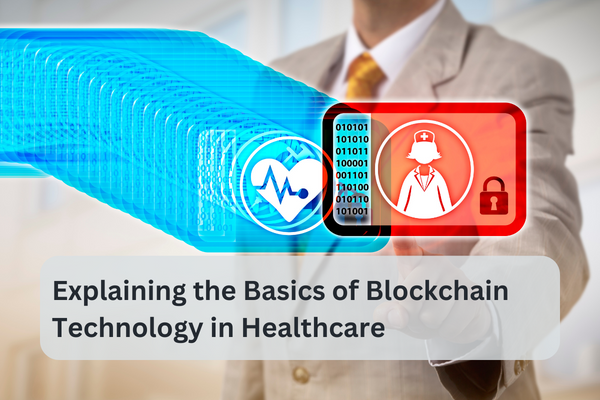Explaining the Basics of Blockchain Technology in Healthcare

 In the digital age, innovative technologies are reshaping various industries, and healthcare is no exception. One technology that has gained significant attention is blockchain. Originally developed to support cryptocurrencies like Bitcoin, blockchain technology has found its way into diverse sectors, including healthcare. This article aims to provide a clear and concise understanding of the basics of blockchain technology in the context of healthcare.
In the digital age, innovative technologies are reshaping various industries, and healthcare is no exception. One technology that has gained significant attention is blockchain. Originally developed to support cryptocurrencies like Bitcoin, blockchain technology has found its way into diverse sectors, including healthcare. This article aims to provide a clear and concise understanding of the basics of blockchain technology in the context of healthcare.
Contents
Understanding Blockchain Technology
At its core, a blockchain is a decentralized and distributed digital ledger that records transactions in a secure and transparent manner. Unlike traditional centralized systems where a single entity has control, blockchain operates on a network of computers, known as nodes. Each node maintains an identical copy of the ledger, ensuring consensus and preventing unauthorized tampering of data.
What Are the Key Features of Blockchain?
1. Decentralization:
One of the fundamental features of blockchain is its decentralized nature. There is no central authority or intermediary controlling the network. This decentralization enhances transparency and reduces the risk of single points of failure.
2. Transparency:
All participants in a blockchain network can view the same data. Transactions are added to the blockchain in chronological order, forming an unchangeable chain of blocks. This transparency can be especially valuable in healthcare, where accurate and accessible patient records are crucial.
3. Immutability:
Once data is added to a blockchain, it becomes extremely difficult to alter. Each block contains a unique code (hash) that is dependent on the data in the block and the previous block’s hash. Any change in the data would require altering subsequent blocks, which is practically impossible due to the computational effort required.
4. Security:
Blockchain employs advanced cryptographic techniques to secure data. Its also known as cryptography. Transactions must be verified before being added to the blockchain, and the consensus mechanism ensures that malicious activities are minimized.
What are the Blockchain Attributes in Healthcare?
Blockchain’s attributes make it a promising technology for the healthcare industry. Here are some ways blockchain is being utilized:
1. Medical Records Management:
Blockchain can provide a secure and interoperable way to store and share patient medical records. Patients would have more control over their data, and healthcare providers can access accurate information, reducing errors and improving patient care.
2. Interoperability:
Healthcare systems often use incompatible formats for data storage. Blockchain’s standardized approach could facilitate data exchange and interoperability among different institutions.
3. Clinical Trials and Research:
Blockchain can enhance transparency and trust in clinical trials by securely recording trial data. Researchers can also ensure the integrity of their findings and prevent data manipulation.
4. Drug Supply Chain Management:
Ensuring the authenticity and safety of pharmaceuticals is critical. Blockchain can track the entire supply chain of drugs, reducing the risk of counterfeit or substandard products.
5. Billing and Claims Processing:
Blockchain can streamline billing processes, reducing administrative costs and preventing fraudulent claims.
What are the Challenges and Considerations of Blockchain in Healthcare?
While blockchain technology presents promising opportunities for transforming the healthcare industry, it is essential to acknowledge and address the challenges and considerations that come with its implementation. From regulatory hurdles to technical limitations, healthcare organizations need to be aware of these factors to make informed decisions about adopting blockchain technology.
1. Regulatory and Legal Challenges:
Healthcare is a highly regulated industry, and introducing blockchain technology can raise complex legal and regulatory issues. Data privacy, patient consent, and compliance with standards such as HIPAA (Health Insurance Portability and Accountability Act) are critical concerns.
Blockchain’s transparency conflicts with certain data protection regulations that require restricting access to sensitive patient information.
2. Interoperability:
Achieving interoperability between existing healthcare systems and a new blockchain-based solution can be challenging. Integrating blockchain with legacy systems and ensuring smooth data exchange is a technical hurdle that requires careful planning.
3. Scalability:
Blockchain networks, especially public ones, can face scalability issues. As the number of transactions increases, the network’s performance might degrade. This is a concern when dealing with the high volume of healthcare transactions.
4. Data Accuracy and Integrity:
While blockchain’s immutability is a strength, it can become a limitation when dealing with erroneous or fraudulent data. Incorrect data that is added to the blockchain cannot be easily corrected without consensus from the entire network.
5. Technical Complexity:
Implementing and maintaining a blockchain network demands specialized technical knowledge. Healthcare organizations might struggle to find skilled professionals who understand both the intricacies of blockchain technology and the complexities of healthcare operations.
6. Energy Consumption:
Proof-of-Work (PoW), a consensus mechanism used in some blockchains, requires significant computational power, leading to high energy consumption. This is an environmental concern that needs to be addressed, especially for sustainable healthcare practices.
7. Patient Identity and Consent:
Verifying patient identity and obtaining informed consent in a blockchain system can be challenging. Striking the right balance between privacy, security, and accessibility is crucial.
8. Education and Adoption:
The healthcare industry might have limited awareness and understanding of blockchain technology. A lack of education can hinder its adoption, as decision-makers need to grasp its potential benefits and limitations.
9. Cost and Investment:
Implementing a blockchain solution requires substantial investment in terms of infrastructure, development, and training. Healthcare organizations need to evaluate the return on investment and long-term sustainability.
10. Vendor Lock-In:
Depending on the blockchain platform or solution chosen, there could be concerns about vendor lock-in. Migrating from one platform to another might be challenging, which could limit flexibility.
Conclusion
In the evolving landscape of healthcare technology, blockchain has emerged as a transformative force with the potential to reshape how patient data is managed, medical processes are streamlined, and trust is established across the healthcare ecosystem. As the adoption of blockchain technology in healthcare market continues to gain momentum, its promises of enhanced security, transparency, and interoperability hold the key to addressing longstanding challenges in the industry.
However, while the possibilities are compelling, it is crucial to navigate the challenges of regulation, scalability, and integration. As stakeholders collaborate to overcome these hurdles, the blockchain technology in the healthcare market is poised for substantial growth, offering a future where patient-centric care, data integrity, and innovation converge to create a more efficient and resilient healthcare system.
You should search for the best market research company that will stand out as a top option if you’re looking for trustworthy and informative market research. The market research company is a great resource for companies looking to traverse complex market landscapes and increase strategic growth because of its wide selection of industry publications, data-driven insights, and reputation for accuracy and authenticity.
You Can Also Read – Top 7 Healthcare IT Market Research Trends to Watch in 2023









